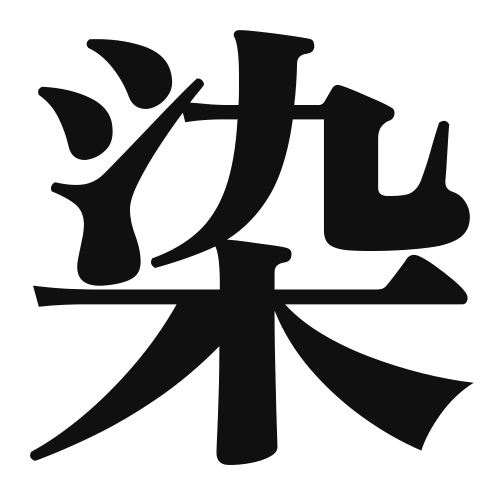1. Overview of Meaning
The kanji “染” (pronounced “sen” or “shime”) means “to dye” or “to color.” It refers to the process of adding color to materials, such as fabric or hair, and can also imply a change in appearance or character.
2. Formation and Radical
Formation of the Kanji: The kanji “染” is a phonetic-ideographic character (形声文字). It combines the radical for water (氵) on the left, indicating a relation to liquids, and the phonetic component “占” (pronounced “sen”), which contributes to its pronunciation.
Radical: The radical of “染” is 氵, which is related to water and liquids, emphasizing the connection to the dyeing process.
3. Examples of Usage
Common Words and Phrases: Some frequently used words that include “染” are:
- 染色 (せんしょく, senshoku) – dyeing
- 染料 (せんりょう, senryou) – dye
- 染める (そめる, someru) – to dye
Example Sentences in Daily Conversation:
- この布は赤に染められています。 (このぬのはあかにそめられています。) – This fabric is dyed red.
- 彼女は髪を青に染めたいと言っています。 (かのじょはかみをあおにそめたいといっています。) – She says she wants to dye her hair blue.
4. Synonyms and Antonyms
Similar Kanji: A similar kanji is “色” (いろ, iro), which means “color.” While “染” specifically refers to the act of dyeing, “色” refers to the concept of color itself.
Antonyms: An antonym could be “抜ける” (ぬける, nukeru), which means “to fade” or “to lose color,” indicating a loss of dye or color rather than the application of it.
5. Cultural and Historical Background
Relation to Japanese Culture: Dyeing has a significant place in Japanese culture, with traditional methods such as “shibori” (tie-dye) and “yuzen” (a method of silk dyeing) being celebrated art forms.
Proverbs and Idioms: One common saying is “色は匂えど散りぬるを” (いろはにおえどちりぬるを), which translates to “Colors may be fragrant, but they will eventually fade,” reflecting the transient nature of beauty and life.
